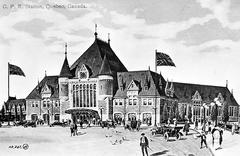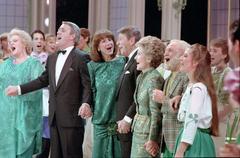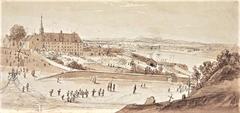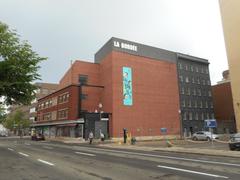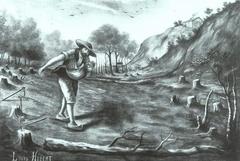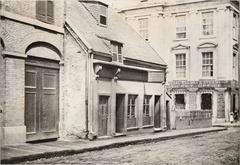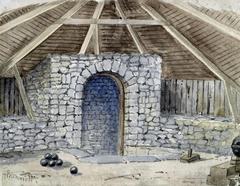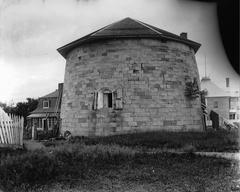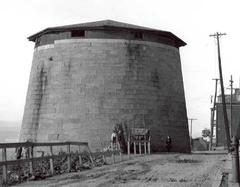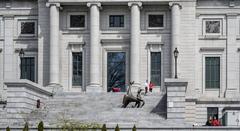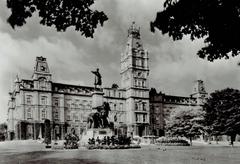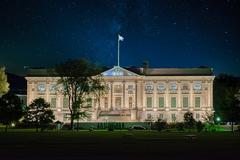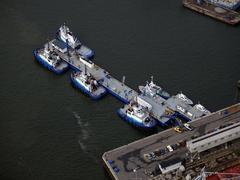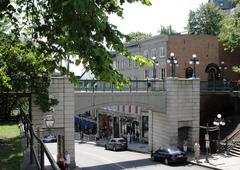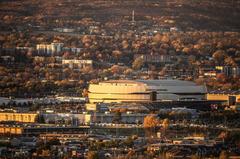Charles De Gaulle Monument Quebec City: Visiting Hours, Tickets, and Comprehensive Travel Guide
Date: 14/06/2025
Introduction
The Charles de Gaulle Monument in Quebec City stands as a powerful tribute to the enduring cultural and political ties between France and Quebec. Erected in 1997, this prominent bronze and granite statue commemorates General Charles de Gaulle, whose visits to Quebec—particularly his landmark 1967 “Vive le Québec libre!” speech—played a defining role in the province’s history and the evolution of its nationalist movement. Nestled at the intersection of Grande Allée Est and Cours du Général-De Montcalm, near key sites like the Manège Militaire and Plains of Abraham, the monument invites visitors to reflect on Quebec’s unique heritage and its continuing dialogue with France.
This detailed guide covers all aspects of visiting the Charles de Gaulle Monument, including its historical significance, practical visitor information, accessibility, nearby attractions, and answers to frequently asked questions. Whether you are a history enthusiast, first-time tourist, or local explorer, this article ensures you have all the information needed for an enriching and memorable visit.
Historical Significance of the Charles de Gaulle Monument
De Gaulle’s Legacy in Quebec
Charles de Gaulle (1890–1970) was a pivotal 20th-century statesman: leader of Free France during World War II and later President of France. His relationship with Quebec is marked by three key visits:
- [1944: De Gaulle visited Quebec City to thank citizens for their support of Free France during the war (Manège Militaire).](#1944:-de-gaulle-visited-quebec-city-to-thank-citizens-for-their-support-of-free-france-during-the-war-(manège-militaire).)
- 1960: As President, he returned to witness the onset of Quebec’s Quiet Revolution and reinforce Franco-Quebec ties.
- [1967: His “Vive le Québec libre!” speech in Montreal electrified Quebec’s nationalist movement and remains a rallying cry for cultural affirmation (The Canadian Encyclopedia; Wikipedia).](#1967:-his-“vive-le-québec-libre!”-speech-in-montreal-electrified-quebec’s-nationalist-movement-and-remains-a-rallying-cry-for-cultural-affirmation-(the-canadian-encyclopedia;-wikipedia).)
The monument, inaugurated on the 30th anniversary of the 1967 visit, honors both de Gaulle’s influence on Quebec’s modern identity and the shared history between France and Quebec.
Monument Features and Artistic Interpretation
Physical Description
The monument features a 3.15-meter-tall bronze statue of Charles de Gaulle, depicted in his military uniform with an arm outstretched in a gesture echoing his 1967 speech. It rests on a solid granite pedestal inscribed with de Gaulle’s name and key dates. The posture and expression evoke determination, vision, and leadership.
Location and Urban Setting
Situated at 805, avenue Wilfrid-Laurier, at the intersection of Grande Allée Est and Cours du Général-De Montcalm, the monument faces the Manège Militaire Voltigeurs de Québec and is steps from the Plains of Abraham (Manège Militaire). The area is part of Quebec City’s historic district, close to the Parliament Building, Old Quebec, and other major landmarks (Québec City Landmarks).
Symbolism
- Military Attire: Represents de Gaulle’s leadership in wartime and his symbolic role in Quebec’s aspirations.
- Outstretched Arm: Conveys hope, liberation, and the forward-looking spirit of the 1967 speech.
- Inscribed Pedestal: Offers historical context in both French and English.
- Placement: The monument’s orientation toward the Parliament Building underscores its political resonance.
Practical Visitor Information
Location and Getting There
- Address: 805, avenue Wilfrid-Laurier, Québec City, QC G1R 2L3
- On Foot: 10-minute walk from Château Frontenac and Dufferin Terrace via Grande Allée Est.
- By Public Transit: Numerous bus routes serve the area (RTC Quebec).
- By Car: Metered parking is available along Grande Allée Est and adjacent streets.
Visiting Hours
- Open 24/7: The monument is an outdoor public site accessible every day, year-round.
- Recommended Times: Daylight hours, especially spring to early autumn, provide optimal conditions for photography and comfort.
Admission
- Free Entry: No ticket or reservation is required.
Accessibility
- Wheelchair Access: Level sidewalks and crosswalks provide access; some surrounding cobblestone streets may be challenging.
- Facilities: No restrooms at the monument, but accessible facilities are available nearby in Old Quebec and at the Parliament Building (Lonely Planet).
Enhanced Visitor Experience
Interpretive Materials
Interpretive plaques in French and English explain de Gaulle’s visits and his significance to Quebec. QR codes and digital resources may be available for further learning.
Guided Tours
While the monument itself does not offer official tours, many walking tours of Old Quebec and the Parliament Hill area include a stop at the site. These tours provide deeper insights into the monument’s cultural and historical importance (Québec City Walking Tours).
Photography Tips
- Lighting: Best photographed in the morning or late afternoon for dramatic shadows and highlights.
- Scenery: The Manège Militaire and tree-lined Grande Allée Est create attractive backdrops.
- Seasonal Appeal: Surrounding gardens and seasonal landscaping enhance visual interest, especially in spring and summer.
Events and Commemorations
Commemorative events are sometimes held at the monument, especially on Bastille Day (July 14) and anniversaries of de Gaulle’s visits. These may include speeches, cultural performances, and official ceremonies.
Nearby Attractions
The monument’s central location makes it an ideal starting point for exploring Quebec City’s historic and cultural sites:
- Plains of Abraham: Adjacent urban park and historic battlefield with walking trails and gardens (Plains of Abraham).
- Manège Militaire Voltigeurs de Québec: National Historic Site with military exhibitions (Manège Militaire).
- Parliament Building: Landmark of Quebec’s political life, offering free guided tours (Québec City Must-See Attractions).
- Old Quebec (Vieux-Québec): UNESCO-listed district with cobblestone streets, fortifications, and iconic sites like Château Frontenac and Dufferin Terrace (Old Québec).
- Observatoire de la Capitale: Panoramic city views and interactive history exhibits (Observatoire de la Capitale).
- Musée de la civilisation: Engaging exhibits on Quebec’s history and culture (Musée de la civilisation).
- Quartier Petit Champlain: Charming neighborhood with shops and eateries (Quartier Petit Champlain).
Dining and Refreshments
Grande Allée Est features a range of restaurants, cafés, and bars, many with outdoor seating in warmer months. This is an excellent area to relax and reflect after your visit.
Safety and Etiquette
- The monument area is safe, well-patrolled, and accessible.
- Please respect the site by not climbing on the statue or leaving litter.
- During commemorative events, observe moments of silence and participate respectfully.
Frequently Asked Questions (FAQ)
What are the Charles de Gaulle Monument’s visiting hours?
The monument is outdoors and accessible 24 hours a day, year-round.
Is there an entrance fee or tickets required?
No, the monument is open to the public free of charge.
Are guided tours available?
While there are no official guided tours at the monument, many city walking tours include it as a point of interest.
Is the monument wheelchair accessible?
Yes, it is accessible via level sidewalks and crosswalks, though some nearby streets have cobblestones.
Are there restrooms nearby?
Public restrooms are available within Old Quebec and at nearby public buildings.
Are there special events at the monument?
Commemorative ceremonies are often held on Bastille Day and on anniversaries related to de Gaulle’s visits.
Legacy and Continuing Relevance
The Charles de Gaulle Monument serves as a lasting symbol of Quebec’s cultural affirmation and the ongoing dialogue between France and Quebec. The site is integrated into the city’s broader commemorative landscape, connecting visitors with significant moments in Quebec’s evolution and encouraging reflection on its place within Canada and the Francophone world. Numerous roads, parks, and even a bridge in Quebec are named after de Gaulle, attesting to his enduring impact (Amerique Francaise).
Plan Your Visit and Access Additional Resources
- For maps, official updates, and event information, visit the City of Quebec tourism website.
- Download the Audiala app for guided audio tours, detailed maps, and updates on Quebec’s historical sites.
Sources
- Manège Militaire
- Ville de Québec Official Heritage Site
- Rare Historical Photos
- Mémoire en Partage
- The Canadian Encyclopedia
- Québec City Landmarks
- Québec City Walking Tours
- Lonely Planet
- Québec City Must-See Attractions
- Amerique Francaise
- Plains of Abraham
- Observatoire de la Capitale
- Musée de la civilisation
- Quartier Petit Champlain
- Wikipedia: Vive le Québec libre



